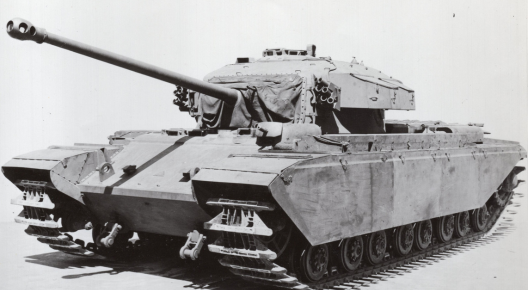Drawings have been found that show a proposal for the FV201 Universal Tank with a flamethrower modification.
Donated many years ago by the Ministry of Defence, the Museum has a very large collection of slide negatives of various plans and drawings. As many of these are unsorted, some interesting finds can be stumbled upon by accident. Such as these really good quality plans from 1949 from The English Electric Company (yes, the same people who made the Canberra and Lighting).

The War Office requirement was originally put forward in early 1945 and was called A45. This was not just for a gun tank; this was to be a family of vehicles with a common hull. The requirement classification system was changed shortly after, and A45 was first referred to as FV200 in October 1946, and each variant would have its own number; for example, ‘Bridge Layer A.45’ became FV208 and ‘Standard A.45’ (the gun tank) became FV201.
While this family of vehicles was intended to replace even the brand-new Centurion (A.41), the project was not successful. By 1948, FV201 had ended up as a Centurion Mark 3 turret on a larger, more expensive, and less mobile hull. The other variants were even less useful than that. The Flail tank could not have the same main armament and had to be significantly modified in order to power the flail itself, and it could not fit in the Navy’s landing craft. The Duplex Drive swimming tank had similar size related issues. The whole project was cancelled in 1949, but the prototype is still going on trials.
The Drawings
The drawings are a submission from English Electric to the Department of Tank Design showing the general arrangement of the flamethrower equipped FV201. As the idea was to have all universal tanks capable of being converted into flamethrowers, this must have been a ‘bolt-on’ addition. The nozzle can be clearly seen in the side elevation at the front of the tank, just above the idler wheel.


The more eagle-eyed reader may have noticed the supposed Centurion Mark 3 turret has a couple of unexpected differences. The least obvious is that the mantlet appears to be smaller than the standard Mark 3, but the reason for this is unclear. The more obvious is that the 20pdr is incorrectly drawn with a muzzle brake. This is not the only set of drawings that illustrates the 84mm gun this way; one reason for this could be that the weapon was supplied by Royal Ordnance and not private industry, so English Electric may have been unaware that unlike its predecessor, the 17pdr, it did not have one.
Caernarvon
At first glance, this iteration of FV201 may appear to be a later tank known as ‘Caernarvon’. While Caernarvon did use a Centurion Mark 3 turret and the hull from the FV200 project, this was given the designation FV221 and was used as a tool to get tank units used to operating a much heavier vehicle in anticipation of the 120mm-armed FV214 Conqueror. In addition to its conceptual differences, the extra crew position and machine gun turret distinguish FV201 from Caernarvon.
Find out more about the Conqueror in David Fletcher’s Tank Chat.





